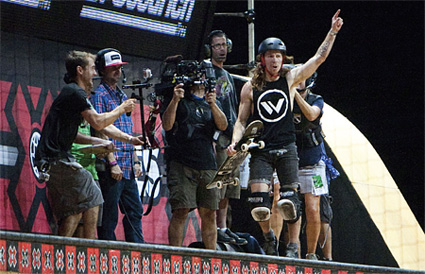ESPN Summer X Games Innovate 3D Production
LOS ANGELES—ESPN's Summer X Games 17 hosted more than 200 international athletes, who defied gravity or powered through obstacle courses to compete in BMX Freestyle, Moto X, Rally Car, and Skateboard events. The dynamic, action-packed extreme sports spectacular took place July 28-31 in downtown Los Angeles.
But behind the scenes, the ESPN production crew also achieved new heights in their own breathtaking stunt—producing live broadcasts of different action sports events from multiple venues for delivery on its ESPN 3D stereo 3DTV network, as well as HD for the ESPN, ESPN2, and ABC networks. The event's international audience was estimated at over 300 million households in 180 countries worldwide. And live webcasts were also delivered via espn3.com, xgames.com, and special Facebook and YouTube X Games sites.

Shaun White celebrates after taking the lead during the Skateboard Vert Final at the X Games 17 in Los Angeles. Photo: Adrian Sanchez-Gonzalez/PI/Landov "While we've broadcast the X Games before in native stereo 3D, we still managed to break new ground on this event, both in the use of stereo 3D and our ambitious production plans," said Phil Orlins, coordinating producer for ESPN. "Producing the X Games is the height of complexity because we need to meet the unique technical challenges and requirements of stereo 3D alongside our 2D telecasts without falling short of the quality our viewers expect."
3D+2D=5D
ESPN's need to produce native stereo 3DTV alongside 2D HDTV gave rise to an innovative "5D" approach—where stereo 3D and 2D are produced on a single mobile unit: SS32 by NEP Broadcasting, LLC in Pittsburgh. SS32, which is actually comprised of an A and B unit, was designed and built according to ESPN specifications for 5D's stereo 3D/HDTV production.
In the 5D workflow, 20 stereo 3D cameras feed both left and right eye signals into the massive 200x100 Sony MVS-8000x production switcher on SS32 to produce the full stereo 3D show, complete with graphics and audio. Then the left-eye portion of the finished stereo 3D program is used to feed the 2D networks, including ESPN, ESPN2, and ABC.
There were approximately 20 stereo 3D camera systems including specially designed Pace stereo 3D camera rigs, and I-MOVIX high-speed (super slomo) cameras designed by Fletcher Chicago.
The SS32 B unit includes dedicated consoles for stereography and image convergence, and key production crewmembers wear stereo 3D glasses to evaluate the product.
"We primarily did 'unilateral 3D' production from our main venue, The Staples Center, which hosted all the Moto X Freestyle and Moto X Racing events," said Stephen Raymond, associate director of event operations for ESPN. "But at other venues, we provided 'shadow coverage,' where the stereo 3D and 2D shows are produced side by side.
"In the case of shadow coverage, the venues would have full 2D camera coverage, supplemented by as many as eight stereo 3D cameras, to produce two different shows at the same time based on the same announcer, storyline, and audio mix," Raymond continued. "Producing unilateral 3D, plus the 2D and 3D shadow coverage, from the same truck are both cost-effective ways to meet the demands of simultaneous 3D and 2D broadcasting."
While there were approximately 35 HD cameras for the shadow coverage and other 2D production, Raymond said occasionally 2D cameras needed to be used for the stereo 3D production. One reason was that stereo 3D cameras do not yet support the use of big box (100X) lenses for extreme close ups at great distances. Extreme close-ups do not noticeably detract from the overall stereo 3D effect.
AVOIDING DEPTH COLLISIONS
"ESPN 3D is a natural medium for delivering visually exciting X Games events," said Raymond. "But graphics placement in stereo 3D continues to be a very challenging problem. Before you key in graphics over video, you have to be mindful of the depth of the image in order to prevent 'depth collisions.'"
With stereo 3D, where the subject can fly towards the viewer, lower third supers and other graphics overlays may not look right if they are not in the right position relative to the video.To prevent this problem, graphics are often keyed at the top of the screen rather than the bottom—where there is less opportunity for collision with the subject—or else graphics are not left on-screen for more than six or seven seconds."
ESPN and SS32 both employ a Vizrt live graphics workflow, including Viz Trio character generators, because their solutions support multiple formats and resolutions including live stereo 3D.
ESPN EVERYWHERE
In a first for this summer's X Games, ESPN produced five distinct live broadcasts for separate networks between 4 p.m. and 6 p.m. on July 30, from several different X Games venues simultaneously. The five telecasts included: Skateboard on ABC HD, Rally Car Racing Finals on ESPN HD, Skateboard Street on ESPN 3D, the Rally Car in-car camera feed sent to espn3.com, and the XCast Webcast companion screen.
In addition to the three telecasts produced from ESPN's three mobile units for ESPN, ABC and ESPN 3D, a special XCast Webcast was produced utilizing the X Games on-site entertainment team's NewTek Tricaster. The XCast webcast featured behind the scenes access and was distributed via online outlets including xgames.com, Facebook.com/xgames and YouTube.com/xgames.
"Instead of covering one event at a time, we decided that each of the events would become unique productions for the network they had to serve," Orlins said. "While this plan was ambitious, all five feeds went off without a hitch and ended perfectly right at 6 p.m."
Get the TV Tech Newsletter
The professional video industry's #1 source for news, trends and product and tech information. Sign up below.

